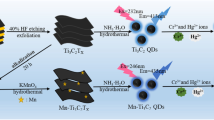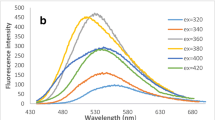Abstract
Quantum dots generate unique luminescent and chemical properties due to the ultra-small particle sizes. In this contribution, a novel silicon nanoparticles (Si-NPs)-based platform has been established via (3-aminopropyl) trimethoxysilane (APS) and ascorbic acid (AA) as raw materials within only 30 min. A switched off effect has been achieved for the determination of Ni2+ ions and the strategy has been simply realized by recording the luminescence changes in the green band of Si-NPs. This developed approach possesses a variety of merits such as label free, low cost, easy post-treatment and convenient operations. The linear equation range is yielded between 0 and 20 μM with the detection limit of 1.73 μM. The nano-sensor provides a versatile route for the monitoring of mercury ions in practical environments.
Similar content being viewed by others
References
Yang XL, Zhang YS, Liu WQ, Gao JW, Zheng YH (2019) Confined synthesis of phosphorus, nitrogen co-doped carbon dots with green luminescence and anion recognition performance. Polyhedron 171:389–395
Zuo PL, Lu XH, Sun ZG, Guo YH, He H (2016) A review on synthesis, properties, characterization and bioanalytical applications of fluorescent carbon dots. Microchim Acta 183:519–542
Pang ST, Zhou Z, Wang QM (2013) Smart 0D nanomaterials assembled by green luminescent terbium hybrids for the detection of tryptophan. J Nanopart Res 15:1495
Zhou Z, Zheng YH, Wang QM (2014) Extension of novel lanthanide luminescent mesoporous nanostructures to detect fluoride. Inorg Chem 53:530–1536
Wu NT, Li Y, Zeng M, Gao JW, Tang YP, Zeng Z, Zheng YH (2019) Design of chalcopyrite-type CuFeSe2 nanocrystals: microstructure, magnetism, photoluminescence and sensing performance. J Solid State Chem 271:292–297
Zhou Z, Wang QM, Zeng Z, Yang LT, Ding XP, Lin N, Cheng ZS (2013) Polyurethane-based Eu(III) luminescent foam as a sensor for recognizing Cu2+ in water. Anal Methods 5:6045–6050
Chen MH, Wen Q, Gu FL, Gao JW, Zhang CC, Wang QM (2018) Mussel chemistry assembly of a novel biosensing nanoplatform based on polydopamine fluorescent dot and its photophysical features. Chem Eng J 342:331–338
Lu D, Tang YP, Gao JW, Wang QM (2018) Concentrated solar irradiation protocols for the efficient synthesis of tri-color emissive carbon dots and photophysical studies. J Mater Chem C 6:13013–13022
Zhou Z, Wang QM, Wang JY, Zhang CC (2015) Imaging two targets in live cells based on rational design of lanthanide organic structure appended carbon dots. Carbon 93:671–680
Lin JT, Wang QM (2014) Systematic studies for the novel synthesis of nano-structured lanthanide fluorides. Chem Eng J 250:190–197
Huo JS, Zheng YF, Wang QM (2014) Preparation of one-dimensional La2-xGdx(MoO4)3-y(WO4)y:Eu3+ amorphous materials by multiple irradiations and in polymeric gels. Chem Eng J 244:350–354
Yadav M, Velampati RS, Mandal D (2018) Microwave-assisted size control of colloidal nickel nanocrystals for colloidal nanocrystals-based non-volatile memory devices. J Electron Mater 47:3560–3567
Wang J, Ye DX, Liang GH, Chang J, Kong JL, Chen JY (2014) One-step synthesis of water-dispersible silicon nanoparticles and their use in fluorescence lifetime imaging of living cells. J Mater Chem B 2(27):4338–4345
Signore A, Mather SJ, Piaggio G, Malviya G, Dierckx RA (2010) Molecular imaging of inflammation/infection: nuclear medicine and optical imaging agents and methods. Chem Rev 110(5):3112–3145
Ye HL, Cai SJ, Si L, He XW, Li WY, Li YH et al (2016) One-pot microwave synthesis of water-dispersible, high fluorescence silicon nanoparticles and their imaging applications in vitro and in vivo. Anal Chem 88(23):11631–11638
Aragay G, Pons J, Merkoçi A (2011) Recent trends in macro-, micro-, and nanomaterial-based tools and strategies for heavy-metal detection. Chem Rev 111(5):3433–3458
Sato K, Tsuji H, Hirakuri K, Fukata N, Yamauchi Y (2009) Controlled chemical etching for silicon nanocrystals with wavelength-tunable photoluminescence. Chem Comm 25(25):3759–3761
Paul A, Jana A, Karthik S, Bera M, Zhao Y, Singh NDP (2016) Photoresponsive real time monitoring silicon quantum dots for regulated delivery of anticancer drugs. J Mater Chem B 4(3):521–528
Chandra S, Beaune G, Shirahata N, Winnik FM (2016) A one-pot synthesis of water soluble highly fluorescent silica nanoparticles. J Mater Chem B (5)7:1363–1370
He Y, Zhong Y, Peng F, Wei X, Su Y, Lu Y, Su S, Gu W, Liao L, Lee ST (2011) One-pot microwave synthesis of water-dispersible, ultraphoto- and pH-stable, and highly fluorescent silicon quantum dots. J Am Chem Soc 133(36):14192–14195
Zhong Y, Peng F, Bao F, Wang S, Ji X, Yang L, Su Y, Lee ST, He Y (2013) Large-scale aqueous synthesis of fluorescent and biocompatible silicon nanoparticles and their use as highly photostable biological probes. J Am Chem Soc 135(22):8350–8356
Yi Y, Zhu G, Liu C, Huang Y, Zhang Y, Li H, Zhao J, Yao S (2013) A label-free silicon quantum dots-based photoluminescence sensor for ultrasensitive detection of pesticides. Anal Chem 85(23):11464–11470
Lin JT, Wang QM (2015) Role of novel silicon nanoparticles in luminescence detection of a family of antibiotics. RSC Adv 5(35):27458–27463
Dhaka G, Kaur N, Singh J (2017) Spectral studies on benzimidazole-based bare eye probe for the detection of Ni2+: application as a solid state sensor. Inorg Chim Acta 464:18–22
Yao QH, Feng YF, Rong MC, He SG, Chen X (2017) Determination of nickel(II) via quenching of the fluorescence of boron nitride quantum dots. Microchim Acta 184:4217–4223
Bunzli JCG, Piguet C (2005) Taking advantage of luminescent lanthanide ions. Chem Soc Rev 34:1048–1077
Barhoumi H, Maaref A, Mlika R, Martelet C, Jaffrezic-Renault N, Ponsonnet L (2005) EIS field effect structures functionalized by p-tert-butylcalix[6]arene for Ni2+ detection. Mater Sci Eng C 25:61–66
Yang Y, Yuan Z, Liu XP, Liu Q, Mao CJ, Niu HL, Jin BK, Zhang SY (2016) Electrochemical biosensor for Ni2+ detection based on a DNAzyme-CdSe nanocomposite. Biosens Bioelectron 77:13–18
Acknowledgements
Y.H. thanks for the support from Guangdong International Science and Technology Cooperation Project (No. 2020A0505100055), Guangzhou Science and Technology Plan (No. 202002030325). Q. Wen thanks for the support from Innovation Project of Graduate School of South China Normal University (2019LKXM009). J. W. appreciates National Natural Science Foundation of China (NSFC)-Guangdong Joint funding support (No. U1801256) and Innovative team project by Department of Education of Guangdong Province (2016KCXTD009).
Author information
Authors and Affiliations
Corresponding authors
Ethics declarations
Statement on Conflicts of Interest
The authors declare that no conflicts of interests in current study and manuscript.
Additional information
Publisher’s Note
Springer Nature remains neutral with regard to jurisdictional claims in published maps and institutional affiliations.
Supplementary Information
ESM 1
(DOCX 738 kb)
Rights and permissions
About this article
Cite this article
Wen, Q., Jiang, C., Liu, W. et al. Fluorescence Determination of Ni2+ Ions Based on a Novel Nano-Platform Derived from Silicon Quantum Dots. Silicon 14, 385–392 (2022). https://doi.org/10.1007/s12633-020-00814-6
Received:
Accepted:
Published:
Issue Date:
DOI: https://doi.org/10.1007/s12633-020-00814-6




